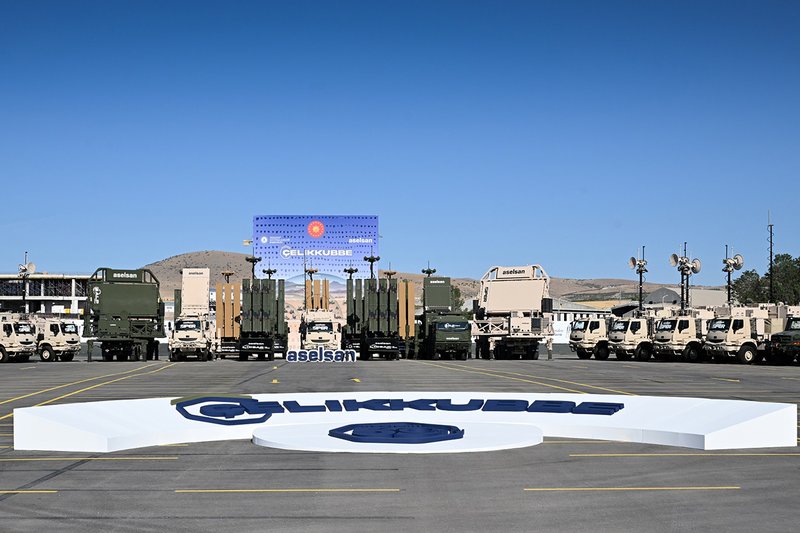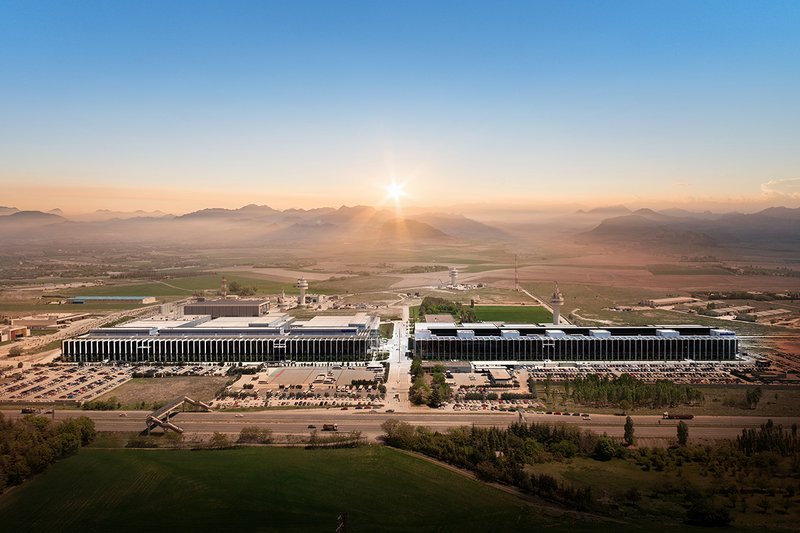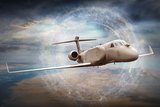“A new philosophy of defence”: ASELSAN sets out ambitions for the future
Since it was founded 50 years ago, ASELSAN has expanded from a manufacturer of military radios to Türkiye’s largest defence company, with capabilities ranging from air defence to electronic warfare (EW). The focus is now on the future, says CEO and President Ahmet Akyol, with growing investment in infrastructure and emerging technologies.
ASELSAN was established on 14 November 1975, during a period when Türkiye was working to develop technological sovereignty and reduce its dependence on foreign defence equipment. The company was initially founded to design and produce secure communication systems for the Turkish Armed Forces.
However, it has grown far beyond military radios over the decades, Akyol said. Today, his organisation oversees a portfolio that includes air defence systems, radar, EW, avionics, electro-optics, underwater platforms and more; its work has also expanded beyond defence to include transportation and healthcare.
Strategic framework
ASELSAN today has more than 13,000 employees and exports to more than 90 countries, with a direct presence in 24. This evolution and growth is guided by its “aselsaneXt” strategic framework, Akyol explained.
“At its core, our strategy focuses on producing best-in-class products, expanding through international partnerships, and developing game-changing technologies, all in service of the global defence industry,” he said.
This framework is guided by five pillars, Akyol noted. Through aTalent, it invests in human capital; aFast is designed to streamline internal processes; aTech leads development of future technologies through integrated roadmaps; aMass expands automation and AI-driven manufacturing; and finally, aBusiness strengthens the company’s export-oriented structure and global competitiveness.
The plan has involved significant investment in new defence technologies, which has fuelled ASELSAN’s efforts across the board. However, one recent development “stands out for its scale, ambition and impact”, said Akyol: the Steel Dome concept.
Networked shield
Steel Dome is the backbone of Türkiye’s multi-layered air and missile defence system in which ASELSAN plays a major role, “a fully networked shield designed to protect national airspace through adaptive, real-time coordination”.
Its mission is to generate a live national air picture while enabling integrated decision-making. Steel Dome connects radars, sensors and effectors through a secure, military-grade 5G communication network, Akyol noted, “creating a resilient and encrypted defence web capable of withstanding electronic and cyber warfare”.
The system is built on three main pillars, he added, with prominent roles for elements that are designed and manufactured by ASELSAN. The first is sensors, including early warning radars, infrared tracking and electronic support, such as the ALP radar family.

The second layer is command and control (C2), based on ASELSAN’s HAKİM system, which effectively serves as the “brain” of Steel Dome, connecting all the other assets. Finally, the network features an effectors pillar, including such ASELSAN systems as KORKUT, ŞAHİN, HİSAR and SİPER.
“The concept has drawn significant international attention, highlighting Türkiye’s emergence as a nation capable of developing and deploying its own fully integrated air and missile defence ecosystem,” Akyol said. “It represents not only a technological achievement but a symbol of strategic independence and national resilience.”
Steel Dome has made significant progress over the past year especially, he added. For instance, ASELSAN unveiled a range of complementary technologies at July’s IDEF 2025 in Istanbul, including the KORAL 200 mobile EW system, the EJDERHA high-power electromagnetic counter-UAV system, and the T-LINK national tactical data link family.
Another significant milestone was reached in August, when 47 critical Steel Dome systems valued at $460 million were delivered to the Turkish Armed Forces with a ceremony attended by Turkish President Erdoğan.
Integration and intelligence
The development of Steel Dome reflects a fundamental need to rethink how nations defend their skies in an era defined by complexity, speed and EW, said Akyol.
“For decades, ASELSAN focused on delivering high-performance radars, C2 systems and EW platforms,” he said. “Yet the rapidly evolving nature of aerial threats, from low-altitude drones to hypersonic missiles, demanded more than incremental advances. It required a new philosophy of defence built on integration, intelligence and sovereignty.”

Akyol highlighted the shift towards open architectures, designed to evolve alongside new threats, and the importance of cyber and electronic resilience. In particular, he highlighted real-time data fusion and AI-driven analysis which allows Steel Dome to learn from operational experience, anticipate new threat patterns and adjust defensive postures autonomously.
“This continuous feedback loop transforms the system into a self-improving defence network that grows smarter and more capable over time,” he noted.
Embracing AI
As demonstrated by its application in Steel Dome, AI is a rapidly evolving focus for ASELSAN. It is not a supplementary capability, Akyol argued, but a strategic cornerstone that defines how other technologies are conceived, developed and deployed.
“AI serves as the foundation of ASELSAN’s software-defined warfare approach, enabling intelligent situational awareness and autonomous decision-making across multi-domain operations. Through AI integration, our platforms now operate with greater precision, faster response times and enhanced adaptability to emerging and asymmetric threats.”
This goes beyond just products, he explained: digitalisation and AI integration have streamlined business processes, generating more than $25 million annually in operational savings. AI also accelerates research and development (R&D), product planning and lifecycle management, as well as powering predictive analytics, sensor fusion and real-time coordination across air, land and naval systems.
“AI is now an integral part of our defence systems and embedded in EW, sonar technologies, air defence, USVs, naval and aerial electro-optic systems and advanced guidance technologies,” Akyol said.
Research capability
AI is just one aspect of ASELSAN’s wider R&D efforts, which also encompass quantum computing, robotics and augmented and virtual reality. Akyol noted that in the first nine months of 2025, R&D expenditures of the company increased by 40% compared to the previous year, reaching $925 million.
In parallel, during the same period, investment aimed at strengthening mass production infrastructure increased to $200 million, nearly doubling from 2024 and “demonstrating our determination to scale both innovation and industrial capacity.”
In August, for instance, the company held the ground-breaking ceremony for its new Oğulbey Technology Base. The largest defence industry investment in Türkiye’s history at $1.5 billion, the 735,000 square metre site will drive development and production of next-generation technologies, including Steel Dome, said Akyol.
Additionally, he said ASELSAN has lately inaugurated 14 facilities dedicated to the design of air defence systems, radar integration, electro-optics, avionics and advanced engineering materials.

This expanding presence will further enhance the company’s role in Türkiye’s defence ecosystem, particularly in areas such as air defence and EW, noted Akyol. As well as Steel Dome, it has developed the ANTIDOT family of EW pods, he said also pointing to the KANGAL and İHTAR anti-drone systems, among a wide range of other equipment.
New markets
The global defence market has become increasingly important for ASELSAN, Akyol said. There have been profound shifts in the landscape, with rising budgets across NATO, the EU, the Middle East, Africa and Asia.
“We continuously analyse operational theatres through our permanent Operational Analysis Board to ensure that our technology development is guided by real-time lessons from the field. This strategic orientation is exemplified in systems such as Steel Dome,” he said.
In the first nine months of this year, the company signed direct and indirect export contracts totalling $1.45 billion, representing a 171% increase compared with the same period of 2024, with more than two million ASELSAN products operating around the world, including a million radios, over 10,000 avionics units and more than 100 air defence systems. ASELSAN is prioritising long-term partnerships in Asia-Pacific, the Middle East, Africa, Europe and Latin America, Akyol noted.
“The goal is clear: to generate over 30% of total revenue from international markets while continuing to rise in global rankings as a trusted provider of next-generation defence technologies.”
The growing focus on the global market is demonstrated by the company’s prominent presence at major defence shows. For example, it introduced the new KORKUT 100/25 air defence system to the international audience at DSEI 2025 in London in September, he noted.
“We don’t just provide products, we also share knowledge, offer technology transfer and support joint development initiatives,” Akyol said. “Through these partnerships, we aim to strengthen self-reliance, promote sustainable defence capabilities and contribute to a more balanced international order.”
Plans for growth
ASELSAN has some ambitious goals for the coming years, with the aim of becoming one of the top 30 global defence companies by 2030. This will demand “a combination of disruptive innovation, high-capacity production and a proactive presence in key international markets”, noted Akyol.
Equally crucial is a focus on mass production, he said. Again, AI will play a central role in the evolution of manufacturing, with advanced automation helping to keep pace with rising demand, particularly in high-priority areas such as smart munitions, radar and electro-optics.
“These efforts not only enhance efficiency and quality control but also reduce delivery times, strengthening our ability to serve both domestic requirements and international partners effectively.”
Ultimately, success will not be measured by market reach or financial performance alone, said Akyol, but by the company’s ability to deliver for its customers in terms of technological capability, strategic deterrence and resilience.
“By embedding intelligence, autonomy and adaptability across all platforms, ASELSAN is preparing for a future in which defence systems do more than react to threats – they anticipate them, providing nations with a decisive operational advantage in a rapidly evolving security environment.”
More from Industry Spotlights
-
![How AI and robotics drive innovation in land-based defence]()
How AI and robotics drive innovation in land-based defence
The future on the frontlines: automation and AI isn’t just about improving efficiency or driving down labour cost - for Pearson Engineering it’s everything.
-
![How satcom is shaping the future of fast, accurate warfare (podcast)]()
How satcom is shaping the future of fast, accurate warfare (podcast)
"Speed is the key advantage and accuracy is the key outcome": Amazon Kuiper Government Solutions’ Rick Freeman talks to Shephard’s Georgia Lewis about how space-as-a-service is transforming defence connectivity and access to satellite capabilities.
-
![How do land and air defense forces defend against complex threats?]()
How do land and air defense forces defend against complex threats?
Learn how RTX systems defend against complex attacks from adversaries including hostile drones, and multi-range missiles.
-
![Fischer KEYSTONE™ Hub: Enabling Next-Gen Command and Control]()
Fischer KEYSTONE™ Hub: Enabling Next-Gen Command and Control
KEYSTONE delivers modular soldier connectivity for NGC2 – customizable with Fischer Connectors’ online configurator.






















